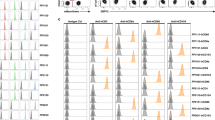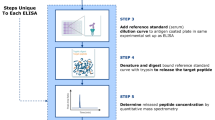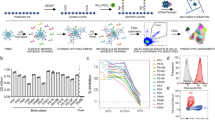Abstract
The enzyme-linked immunospot (ELISPOT) assay was originally developed to enumerate antigen-specific antibody-secreting cells (ASCs), and has subsequently been adapted for various applications, including the detection cytokine-secreting cells. Owing to its exceptionally high sensitivity, the ELISPOT has proven to be especially useful for detecting discrete populations of active cells (e.g., antigen-specific cells). Because of its versatility, the ELISPOT assay is used for a wide range of applications, including clonal analyses of immune responses after vaccination or after immunotherapy. Here we describe standard protocols for the detection of human ASCs specific to virtually any vaccine antigen after enrichment of circulating plasmablasts. In addition, a protocol is described for the measurement of mucosal ASC responses after prior immunomagnetic enrichment of mucosally derived blood lymphocytes. The protocols described allow rapid (∼6–8 h) detection of specific ASCs in small (1–2 ml) samples of blood and can be performed in resource-poor settings.
This is a preview of subscription content, access via your institution
Access options
Subscribe to this journal
Receive 12 print issues and online access
$259.00 per year
only $21.58 per issue
Buy this article
- Purchase on Springer Link
- Instant access to full article PDF
Prices may be subject to local taxes which are calculated during checkout







Similar content being viewed by others
References
Plotkin, S. Vaccines: correlates of vaccine-induced immunity. Clin. Infect. Dis. 47, 401–409 (2008).
Quiding, M. et al. Intestinal immune responses in humans. Oral cholera vaccination induces strong intestinal antibody responses and interferon-gamma production and evokes local immunological memory. J. Clin. Invest. 88, 143–148 (1991).
Kozlowski, P.A., Cu-Uvin, S., Neutra, M.R. & Flanigan, T.P. Comparison of the oral, rectal, and vaginal immunization routes for induction of antibodies in rectal and genital tract secretions of women. Infect. Immun. 65, 1387–1394 (1997).
Stevens, R.H., Macy, E., Morrow, C. & Saxon, A. Characterization of a circulating subpopulation of spontaneous antitetanus toxoid antibody producing B cells following in vivo booster immunization. J. Immunol. 122, 2498–2504 (1979).
Yarchoan, R., Murphy, B.R., Strober, W., Clements, M.L. & Nelson, D.L. In vitro production of anti-influenza virus antibody after intranasal inoculation with cold-adapted influenza virus. J. Immunol. 127, 1958–1963 (1981).
Kutteh, W.H., Koopman, W.J., Conley, M.E., Egan, M.L. & Mestecky, J. Production of predominantly polymeric IgA by human peripheral blood lymphocytes stimulated in vitro with mitogens. J. Exp. Med. 152, 1424–1429 (1980).
Tarkowski, A. et al. Cellular origins of human polymeric and monomeric IgA: enumeration of single cells secreting polymeric IgA1 and IgA2 in peripheral blood, bone marrow, spleen, gingiva and synovial tissue. Clin. Exp. Immunol. 85, 341–348 (1991).
Kutteh, W.H., Prince, S.J. & Mestecky, J. Tissue origins of human polymeric and monomeric IgA. J. Immunol. 128, 990–995 (1982).
Friman, V. et al. Intestinal and circulating antibody-forming cells in IgA-deficient individuals after oral cholera vaccination. Clin. Exp. Immunol. 95, 222–226 (1994).
Quiding, M. et al. Induction of specific antibody responses in the human nasopharyngeal mucosa. Adv. Exp. Med. Biol. 371B, 1445–1450 (1995).
Quiding-Jarbrink, M. et al. Differential expression of tissue-specific adhesion molecules on human circulating antibody-forming cells after systemic, enteric, and nasal immunizations. A molecular basis for the compartmentalization of effector B cell responses. J. Clin. Invest. 99, 1281–1286 (1997).
Kantele, A. Peripheral blood antibody-secreting cells in the evaluation of the immune response to an oral vaccine. J. Biotechnol. 26, 217–224 (1996).
Kunkel, E. & Butcher, E. Plasma-cell homing. Nat. Rev. Immunol. 3, 822–829 (2003).
Kunkel, E.J. et al. Lymphocyte CC chemokine receptor 9 and epithelial thymus-expressed chemokine (TECK) expression distinguish the small intestinal immune compartment: epithelial expression of tissue-specific chemokines as an organizing principle in regional immunity. J. Exp. Med. 192, 761–768 (2000).
Bowman, E.P. et al. The intestinal chemokine thymus-expressed chemokine (CCL25) attracts IgA antibody-secreting cells. J. Exp. Med. 195, 269–275 (2002).
Kunkel, E.J. et al. CCR10 expression is a common feature of circulating and mucosal epithelial tissue IgA Ab-secreting cells. J. Clin. Invest. 111, 1001–1010 (2003).
Sundstrom, P., Lundin, S.B., Nilsson, L.A. & Quiding-Jarbrink, M. Human IgA-secreting cells induced by intestinal, but not systemic, immunization respond to CCL25 (TECK) and CCL28 (MEC). Eur. J. Immunol. 38, 3327–3338 (2008).
Brandtzaeg, P. & Pabst, R. Let's go mucosal: communication on slippery ground. Trends Immunol. 25, 570–577 (2004).
Sedgwick, J.D. & Holt, P.G. A solid-phase immunoenzymatic technique for the enumeration of specific antibody-secreting cells. J. Immunol. Methods 57, 301–309 (1983).
Czerkinsky, C.C., Nilsson, L.A., Nygren, H., Ouchterlony, O. & Tarkowski, A. A solid-phase enzyme-linked immunospot (ELISPOT) assay for enumeration of specific antibody-secreting cells. J. Immunol. Methods 65, 109–121 (1983).
Jerne, N.K. & Nordin, A.A. Plaque formation in agar by single antibody-producing cells. Science 140, 405 (1963).
Engvall, E. & Perlmann, P. Enzyme-linked immunosorbent assay (ELISA). Quantitative assay of immunoglobulin G. Immunochemistry 8, 871–874 (1971).
Towbin, H., Staehelin, T. & Gordon, J. Electrophoretic transfer of proteins from polyacrylamide gels to nitrocellulose sheets: procedure and some applications. Proc. Natl. Acad. Sci. USA 76, 4350–4354 (1979).
Moller, S.A. & Borrebaeck, C.A. A filter immuno-plaque assay for the detection of antibody-secreting cells in vitro. J. Immunol. Methods 79, 195–204 (1985).
Franci, C., Ingles, J., Castro, R. & Vidal, J. Further studies on the ELISA-spot technique. Its application to particulate antigens and a potential improvement in sensitivity. J. Immunol. Methods 88, 225–232 (1986).
Czerkinsky, C., Moldoveanu, Z., Mestecky, J., Nilsson, L.A. & Ouchterlony, O. A novel two colour ELISPOT assay. I. Simultaneous detection of distinct types of antibody-secreting cells. J. Immunol. Methods 115, 31–37 (1988).
Barington, T., Sparholt, S., Juul, L. & Heilmann, C. A simplification of the enzyme-linked immunospot technique. Increased sensitivity for cells secreting IgG antibodies to Haemophilus influenzae type B capsular polysaccharide. J. Immunol. Methods 156, 191–198 (1992).
Lakew, M., Nordstrom, I., Czerkinsky, C. & Quiding-Jarbrink, M. Combined immunomagnetic cell sorting and ELISPOT assay for the phenotypic characterization of specific antibody-forming cells. J. Immunol. Methods 203, 193–198 (1997).
Amano, M., Martin, J., McGhee, J., McCutcheon, M. & Kiyono, H. Immunofluorescence-digital image processing system for the quantitation of secreted immunoglobulin by single cells. J. Immunol. Methods 144, 127–140 (1991).
Bromage, E., Stephens, R. & Hassoun, L. The third dimension of ELISPOTs: quantifying antibody secretion from individual plasma cells. J. Immunol. Methods 346, 75–79 (2009).
Gazagne, A. et al. A Fluorospot assay to detect single T lymphocytes simultaneously producing multiple cytokines. J. Immunol. Methods 283, 91–98 (2003).
Dosenovic, P. et al. Selective expansion of HIV-1 envelope glycoprotein-specific B cell subsets recognizing distinct structural elements following immunization. J. Immunol. 183, 3373–3382 (2009).
Tarkowski, A., Czerkinsky, C. & Nilsson, L.A. Simultaneous induction of rheumatoid factor- and antigen-specific antibody-secreting cells during the secondary immune response in man. Clin. Exp. Immunol. 61, 379–387 (1985).
Carpenter, C.M. et al. Comparison of the antibody in lymphocyte supernatant (ALS) and ELISPOT assays for detection of mucosal immune responses to antigens of enterotoxigenic Escherichia coli in challenged and vaccinated volunteers. Vaccine 24, 3709–3718 (2006).
Chang, H.S. & Sack, D.A. Development of a novel in vitro assay (ALS assay) for evaluation of vaccine-induced antibody secretion from circulating mucosal lymphocytes. Clin. Diagn. Lab. Immunol. 8, 482–488 (2001).
Qadri, F. et al. Antigen-specific immunoglobulin A antibodies secreted from circulating B cells are an effective marker for recent local immune responses in patients with cholera: comparison to antibody-secreting cell responses and other immunological markers. Infect. Immun. 71, 4808–4814 (2003).
Baqar, S. et al. Standardization of measurement of immunoglobulin-secreting cells in human peripheral circulation. Clin. Diagn. Lab. Immunol. 4, 375–379 (1997).
Kyu, S. et al. Frequencies of human influenza-specific antibody secreting cells or plasmablasts post vaccination from fresh and frozen peripheral blood mononuclear cells. J. Immunol. Methods 340, 42–47 (2009).
Rott, L.S., Briskin, M.J. & Butcher, E.C. Expression of α4β7 and E-selectin ligand by circulating memory B cells: implications for targeted trafficking to mucosal and systemic sites. J. Leukoc. Biol. 68, 807–814 (2000).
Mei, H. et al. Blood-borne human plasma cells in steady state are derived from mucosal immune responses. Blood 113, 2461–2469 (2009).
Nygren, H., Czerkinsky, C. & Stenberg, M. Dissociation of antibodies bound to surface-immobilized antigen. J. Immunol. Methods 85, 87–95 (1985).
Zhang, W. & Lehmann, P. Objective, user-independent ELISPOT data analysis based on scientifically validated principles. Methods Mol. Biol. 792, 155–171 (2012).
Janetzki, S. & Britten, C.M. The impact of harmonization on ELISPOT assay performance. Methods Mol. Biol. 792, 25–36 (2012).
Acknowledgements
We thank M. Ali for advice on data analyses and P. Sharma for technical and logistical support. This article describes protocols that have matured from studies supported in part by the Bill & Melinda Gates Foundation (grants OPP1017157 and PROVIDE), the European Union Seventh Framework Program (grant 280873 ADITEC), the World Health Organization (WHO; Global Polio Eradication Program), PATH Vaccine Solutions (EVI Program), Institut National de la Santé et de la Recherche Médicale (INSERM, France), the Swedish Agency for International Cooperation (SIDA) and the Swedish National Research Council. Merck Vaccines (USA), Green Cross Vaccines (South Korea), Sanofi-Pasteur (France), Crucell (the Netherlands) and the National Institute for Public Health and the Environment (RIVM, the Netherlands) are kindly acknowledged for providing reagents and vaccines. The International Vaccine Institute is supported by the governments of the Republic of Korea, Sweden and the Netherlands.
Author information
Authors and Affiliations
Contributions
G.S., N.Ç. and C.C. designed the experiments. G.S., N.Ç., J.S.Y. and A.D. performed the experiments and analyzed data. G.S., A.D. and C.C. wrote the paper.
Corresponding author
Ethics declarations
Competing interests
The authors declare no competing financial interests.
Rights and permissions
About this article
Cite this article
Saletti, G., Çuburu, N., Yang, J. et al. Enzyme-linked immunospot assays for direct ex vivo measurement of vaccine-induced human humoral immune responses in blood. Nat Protoc 8, 1073–1087 (2013). https://doi.org/10.1038/nprot.2013.058
Published:
Issue Date:
DOI: https://doi.org/10.1038/nprot.2013.058
This article is cited by
-
Production and use of antigen tetramers to study antigen-specific B cells
Nature Protocols (2024)
-
Signs of immunosenescence correlate with poor outcome of mRNA COVID-19 vaccination in older adults
Nature Aging (2022)
-
A cell-based in vitro assay for testing of immunological integrity of Tetanus toxoid vaccine antigen
npj Vaccines (2021)
-
Deep phenotypic characterization of immunization-induced antibacterial IgG repertoires in mice using a single-antibody bioassay
Communications Biology (2020)
-
The effect of pneumococcal immunization on total and antigen-specific B cells in patients with severe chronic kidney disease
BMC Immunology (2019)
Comments
By submitting a comment you agree to abide by our Terms and Community Guidelines. If you find something abusive or that does not comply with our terms or guidelines please flag it as inappropriate.



